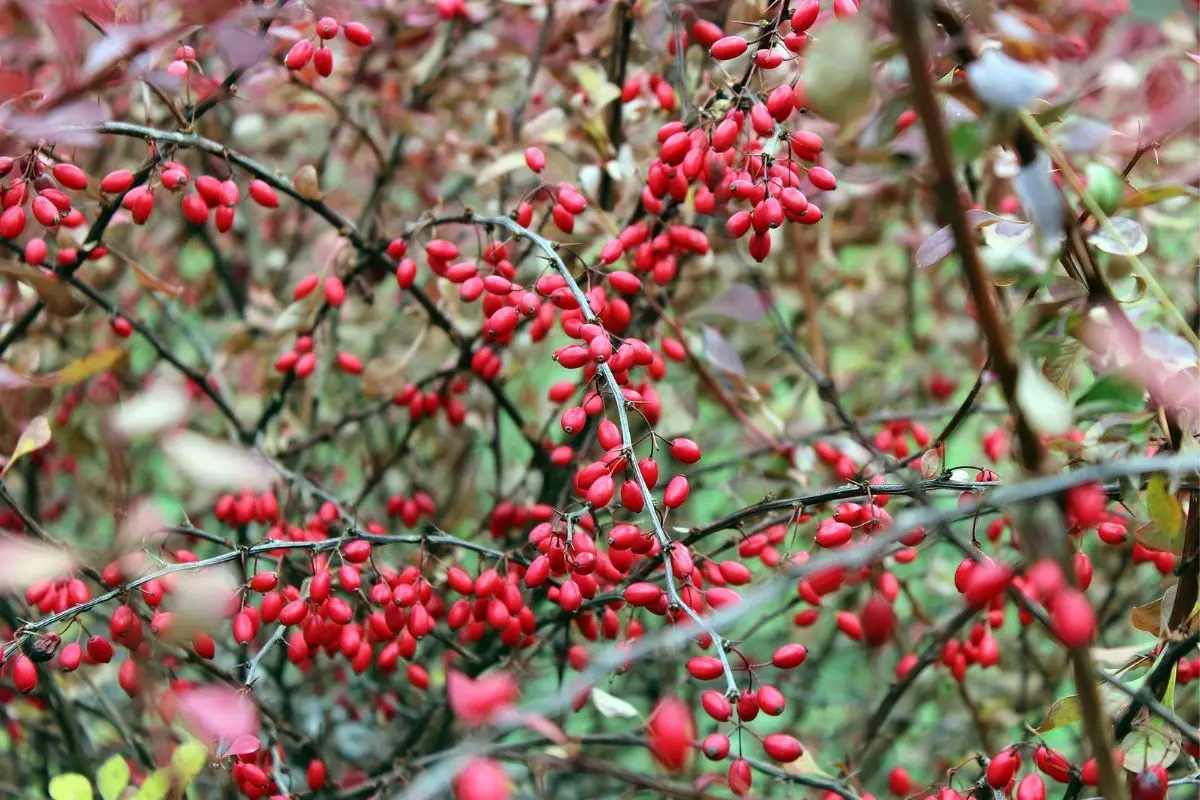Berberis is a large genus of thorny shrubs with around 500 recognized species. This plant is a global resident, thriving in temperate and subtropical areas across the Americas, Asia, Europe, and Africa.
In certain regions, barberry cultivation is banned because the shrub contains the fungus spores that cause stem rust – a devastating disease in wheat production.
This perennial can be deciduous or evergreen. Some species have thorns, others don’t. It is commonly known as the barberry and grows between 1 and 5 m in height.
History
The berberis first found its way to the United States in the 1600s and was popular as a hedging shrub. The fruits were used to make jam, and the pigment contained in the berries was turned into a dye.
The common barberry is an invasive plant. By the early 1900s, it was recognized as being a significant cause of rust disease and damaged wheat crops in America.
From the early 1900s until the 1970s, it was included in an eradication program aiming to kill the plant. During this period, millions of common berberis shrubs were killed.
The Japanese barberry was promoted as being disease resistant, but this plant too is considered harmful.
Plant Facts
| Scientific name | Berberis vulgaris Berberis thunbergii |
| Common names | Common barberry Japanese barberry |
| Genus | Berberis |
| Family | Berberidaceae |
| Height | 1 to 5 m |
| Width | 1 – 3 m |
| USDA Plant Hardiness Zone | USDA zones 4 to 8 |
| Native to | Across the world except Australia |
| Blooming season | spring |
| Flower colors | yellow |
| Plant specific features | Attractive red autumn foliageMulti seasonal interest with flowers and berries |
How to Plant and Grow Berberis Shrubs
This is a popular plant grown in home gardens across the world. Its dazzling foliage comes in a wide range of colors including vivid red, burgundy, and orange.
You should dig a hole that is much larger than the container in which it currently grows. If you cut the pot away from the plant, this will loosen the root ball, and ensure the small roots are not damaged.
Backfill the soil around the newly planted berberis and water well.
Where to Plant
For best results, plant barberry bushes in a sunny position; The warmer the growing area, the more shade you should provide. Leaves can scorch if they receive too much hot sun.
Berberis is a good hedging or screening plant. It will tolerate high pollution levels and salt residue, so can be planted as a roadside hedge.
When to Plant
The best time to plant berberis is in the spring or fall.
Berberis Bushes Care and Maintenance
Soil
These non-fussy shrubs will tolerate most soil types; For ideal results, provide a rich, well-draining soil that is slightly alkaline.
If you add a thick layer of mulch when you plant the barberry, you will help moisture retention in the soil and also discourage weed growth around the shrub’s base. This will aid the plant establish a strong root system.
Water
Water well just after planting; thereafter, the barberry has low water needs.
Fertilizer
Fertilizer is not necessary; an annual mulch just before the onset of winter will act as a soil conditioner and protect the roots from freezing in the soil. Keep the mulch away from the stem, otherwise, there is a risk of rot.
Sunlight
This evergreen will do well either in full sun or partial shade.
Pruning and Repotting
Pruning isn’t necessary but can be carried out if you want to control the growth of the plant. By cutting back the shrub, you can shape the berberis, and of course, pruning is an effective method for the removal of dead or diseased wood.
If you prune to shape your shrub, you should do so in the winter after the plant has finished fruiting.
Propagating
You can sow berberis seeds at any time of the year. However, it’s best to plant outdoor seeds in the fall. After exposure to a period of cold temperatures, they will germinate in the spring when the soil starts to warm.
Pests and diseases
With relatively few problems, this is an easy, trouble-free plant. Deer hate berberis, especially the thorny varieties.
Insects such as the aphid, webworm, and the Japanese weevil can attack the berberis. The best way to control such pests is by using an insecticidal soap. This will stop the eggs and larvae from overwintering in the soil.
Temperature and Humidity
The berberis is hardy from zones 3 to 10.
Other Uses for Berberis
A thorny variety of berberis is a useful plant to grow as a border plant; ideal to give you privacy and discourage unwanted visitors.
Types of Berberis (Barberry) You Can Grow
The berberis genus is huge; there are around 500 different species of both evergreen and deciduous varieties. There are thorny and smooth-branched shrubs available.
Barberry shrubs can be compact or free growing, so it is a good idea to select one that is adapted to your planting site.
The dwarf varieties are useful for low hedges. They can also be used for houseplants.
The European barberry was unwelcome in America due to its invasiveness and because the plant acted as a host for the serious stem rust disease in wheat crops. The Japanese barberry was found to be resistant, so eventually became a permitted import.
Conclusion
There are other plants that you can grow that will provide you with attractive foliage, brightly colored berries, and multi-seasonal interest. So, if you live in a region where berberis is banned or not able to be imported, don’t despair!
However, if you can grow it, you will be rewarded for very little effort. As an added plus, pollinators such as insects and butterflies will be attracted to your garden. This will result in an increased number of birds and wildlife.
*image by Abydika/depositphotos

